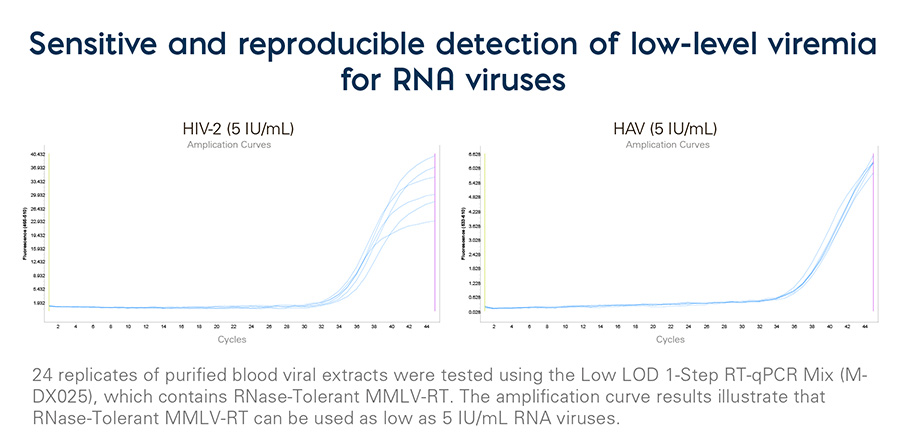Home » Life Science » Products » Molecular Reagents » RNase-Tolerant MMLV-RT
RNase-Tolerant MMLV-RT
RNase-Tolerant MMLV-RT is a reverse transcriptase/RNase inhibitor mix optimized for one-step RT-qPCR. RNase-Tolerant MMLV-RT is used for the detection of RNA at very low levels, it can also be used with a broader temperature range, making it ideal for applications such as blood bank or transplant viral testing.
Have questions about a product?
Meridian's RNase-Tolerant MMLV-RT
- Highly sensitive cDNA synthesis, even low concentrations of template RNA
- Broader temperature range, up to 50°C, for more challenging transcripts
- High efficiency where samples are likely to contain inhibitors
- High-quality, first-strand cDNA synthesis ideal for most one-step RT-qPCR

RNase-Tolerant MMLV-RT, MDX043
For the detection of RNA at very low levels, it can also be used with a broader temperature range, making it ideal for applications such as blood bank or transplant viral testing.
Documents & Resources
Description
A Moloney Murine Leukemia Virus (MMLV) Reverse Transcriptase (RT), which exhibits high sensitivity and efficiency, and RNase Inhibitor (Ribonuclease Inhibitor) which inhibits a broad spectrum of eukaryotic RNases, including RNases A, B and C. RNase-Tolerant MMLV-RT shows no inhibition of polymerase or reverse transcriptase activity, so can be used in cDNA synthesis or one-step RT-qPCR reactions. RNase-Tolerant MMLV-RT is useful in any applications where the presence of RNases is a potential problem.
Specifications
| Description | RNase-Tolerant MMLV-RT (Moloney Murine Leukemia Virus Reverse Transcriptase) for the detection of RNA at very low levels, it can also be used with a broader temperature range, making it ideal for applications such as blood bank or transplant viral testing. |
| Concentration | 100x |
| Appearance | Clear, colorless solution |
| Application | cDNA synthesis, RT-PCR, PCR, two-step RT-qPCR, one-step RT-qPCR |
| Sample type | RNA |
| Presentation | 1 vial |
| Storage | -20 °C |
| Mix stability | See outer label |
| Consistency | ± 0.5 Ct variance between test and reference sample |
| DNA contamination | None detected in PCR amplification with traces overlay with the negative control on E. coli and mouse genomic DNA specific targets. |
| DNase/RNase Contamination | No detectable degradation |
Catalogs & Brochures
FAQs: RNase-Tolerant MMLV-RT
I want to use viral RNA with very high secondary structure for cDNA synthesis, can I use RNase-Tolerant MMLV-RT?
For RNA with very high secondary structure, we recommend using 55C MMLV-RT (MDX117), this is a glycerol-free reverse transcriptase can be used at temperatures up to 60°C which improves the cDNA yield from difficult RNA targets that require higher temperature to denature strong secondary structures. You can add RNase Inhibitor (MDX056) to increase the RNase tolerance.
What buffer do you recommend using with RNase-Tolerant MMLV-RT?
If you are going to make cDNA, you will require a buffer that contains 0.2 mM each dATP, dCTP, dGTP & dTTP, 10 mM DTT (dithiothreitol), 25 mM KCl, 3.5 mM MgCl2 and 50 mM Tris–HCl (7.5). However, if you want to do RT-qPCR, we recommend 1-Step RT-qPCR Buffer (MDX034).
How is RNase-Tolerant MMLV-RT inactivated?
The reverse transcriptase can be inactivated by adding a chelating agent such as EDTA or heating to 70°C or higher for 10 min.
Does RNase-Tolerant MMLV-RT need a primer?
Yes, to initiate cDNA synthesis, the RNase-Tolerant MMLV-RT reverse transcriptase requires a primer to bind to its complementary sequences on the RNA template and serve as a starting point for synthesis of a new strand. For general cDNA synthesis, random hexamer primers and oligo(dT) primers can be used either separately or mixed. For RT-PCR and RT-qPCR gene-specific primers should be used.
What is the error rate of RNase-Tolerant MMLV-RT?
Unlike eukaryotic replicative polymerases, reverse transcriptase lacks exonuclease activity and so is error prone. MMLV-based reverse transcriptase has been reported to have an error rate in the range of 1.1 × 10−4 to 4.8 × 10−4.
Get In Touch With A Specialist
Have questions about a product? Want to learn more about Meridian’s molecular or immunoassay reagent portfolio? We want to hear from you!
By submitting your information in this form, you agree that your personal information may be stored and processed in any country where we have facilities or service providers, and by using our “Contact Us” page you agree to the transfer of information to countries outside of your country of residence, including to the United States, which may provide for different data protection rules than in your country. The information you submit will be governed by our Privacy Statement.